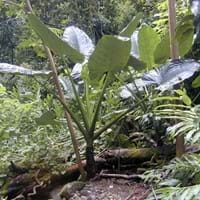Life Span
Perennial
Perennial
Type
Bulb or Corm or Tuber
Tender Perennial
Origin
South America
Southeastern Asia
Types
Pamianthe cardenasii , Pamianthe parviflora , Pamianthe peruviana
Taro Alocasia reginula, Night scented lily
Number of Varieties
Not Available
Habitat
All sorts of environments
Terrestrial, Wet lands
USDA Hardiness Zone
8-10
10-15
Sunset Zone
21,22
H1, H2, 22, 23, 24
Habit
Clump-Forming
Cushion/Mound-forming
Flower Color Modifier
Bicolor
Not Available
Fruit Color
Green
Not Available
Leaf Color in Spring
Dark Green
Purple, Dark Green, Silver, Black
Leaf Color in Summer
Light Green
Purple, Dark Green, Silver, Black
Leaf Color in Fall
Several shades of Green
Purple, Dark Green, Silver, Black
Leaf Color in Winter
Light Green
Green, Dark Green, Silver, Black
Leaf Shape
Strap shaped
Heart-shaped
Plant Season
Spring, Summer, Fall
Spring, Summer, Fall, Winter
Sunlight
Partial Sun, Partial shade
Full Sun, Partial Sun, Partial shade, Full Shade
Type of Soil
Loam, Sand
Loam
The pH of Soil
Acidic, Neutral, Alkaline
Acidic, Neutral, Alkaline
Soil Drainage
Average
Well drained
Bloom Time
Spring, Late Spring, Early Summer, Summer, Late Summer
Indeterminate
Tolerances
Drought
Full Sun, Humidity
Where to Plant?
Ground, Pot
Container, Ground, Pot
How to Plant?
Offsets
Divison, From bulbs, From Rhizomes
Plant Maintenance
Medium
Low
Watering Requirements
Keep the ground moist but not water-logged
Average Water Needs, Do Not over Water, Never Over-water, Water Deeply
In Summer
Lots of watering
Lots of watering
In Spring
Moderate
Average Water
In Winter
Average Water
Less Watering
Soil pH
Acidic, Neutral, Alkaline
Acidic, Neutral, Alkaline
Soil Type
Loam, Sand
Loam
Soil Drainage Capacity
Average
Well drained
Sun Exposure
Partial Sun, Partial shade
Full Sun, Partial Sun, Partial shade, Full Shade
Pruning
Pinch or prune as they grow to promote branching and bushiness, Remove damaged leaves, Remove dead branches, Remove dead leaves, Requires little pruning
Prune to stimulate growth, Remove damaged leaves, Remove dead leaves, Remove deadheads
Fertilizers
All-Purpose Liquid Fertilizer, High phosphorus
All-Purpose Liquid Fertilizer, Nitrogen, Phosphorous, Potassium
Pests and Diseases
Leaf spot, Mosaic viruses
Blight, Mites, Red spider mite
Plant Tolerance
Drought
Full Sun, Humidity
Flowers
Showy
Insignificant
Flower Petal Number
Single
Single
Foliage Texture
Coarse
Medium
Foliage Sheen
Glossy
Matte
Attracts
Bees, Birds, Bumblebees, Butterflies, Hummingbirds, pollinators
Spider Mites
Aesthetic Uses
Beautification, Bouquets, Ornamental use, Showy Purposes
Beautification, Showy Purposes
Beauty Benefits
No Beauty Benefits
No Beauty Benefits
Environmental Uses
Air purification
Air purification, Food for insects
Medicinal Uses
No Medicinal Use
No Medicinal Use
Part of Plant Used
Not Available
Not Available
Other Uses
Beneficial species for attracting pollinators, Decoration Purposes
Air freshner, Decoration Purposes, Showy Purposes, Used as Ornamental plant
Used As Indoor Plant
No
Yes
Used As Outdoor Plant
Yes
Yes
Garden Design
Bog Garden, Container, Feature Plant, Foundation, Mixed Border, Water Gardens
Bedding Plant, Container, Feature Plant, Houseplant, Mixed Border, Tropical
Botanical Name
HYMENOCALLIS longipetala
ALOCASIA reginula
Common Name
Peruvian Daffodil, Spiderlily
Elephant Ear
In Hindi
peruvian daffodil
Elephant Ear
In German
peruvian daffodil
Elephant Ear
In French
peruvian daffodil
Elephant Ear
In Spanish
Pamianthe
Elephant Ear
In Greek
peruvian daffodil
Elephant Ear
In Portuguese
peruvian daffodil
Elephant Ear
In Polish
peruvian daffodil
Elephant Ear
In Latin
peruvian daffodil
Elephant Ear
Phylum
Magnoliophyta
Magnoliophyta
Class
Liliopsida
Liliopsida
Order
Asparagales
Alismatales
Family
Amaryllidaceae
Araceae
Clade
Angiosperms, Monocots
Angiosperms, Monocots
Tribe
Clinantheae
Colocasiodeae
Subfamily
Amaryllidoideae
Aroideae
Number of Species
Not Available
Season and Care of Peruvian Daffodil and Elephant Ear
Season and care of Peruvian Daffodil and Elephant Ear is important to know. While considering everything about Peruvian Daffodil and Elephant Ear Care, growing season is an essential factor. Peruvian Daffodil season is Spring, Summer and Fall and Elephant Ear season is Spring, Summer and Fall. The type of soil for Peruvian Daffodil is Loam, Sand and for Elephant Ear is Loam while the PH of soil for Peruvian Daffodil is Acidic, Neutral, Alkaline and for Elephant Ear is Acidic, Neutral, Alkaline.
Peruvian Daffodil and Elephant Ear Physical Information
Peruvian Daffodil and Elephant Ear physical information is very important for comparison. Peruvian Daffodil height is 61.00 cm and width 61.00 cm whereas Elephant Ear height is 20.30 cm and width 30.50 cm. The color specification of Peruvian Daffodil and Elephant Ear are as follows:
Peruvian Daffodil flower color: White
Peruvian Daffodil leaf color: Dark Green
Elephant Ear flower color: White
- Elephant Ear leaf color: Purple, Dark Green, Silver and Black
Care of Peruvian Daffodil and Elephant Ear
Care of Peruvian Daffodil and Elephant Ear include pruning, fertilizers, watering etc. Peruvian Daffodil pruning is done Pinch or prune as they grow to promote branching and bushiness, Remove damaged leaves, Remove dead branches, Remove dead leaves and Requires little pruning and Elephant Ear pruning is done Prune to stimulate growth, Remove damaged leaves, Remove dead leaves and Remove deadheads. In summer Peruvian Daffodil needs Lots of watering and in winter, it needs Average Water. Whereas, in summer Elephant Ear needs Lots of watering and in winter, it needs Less Watering.





